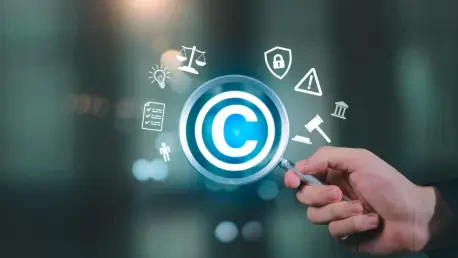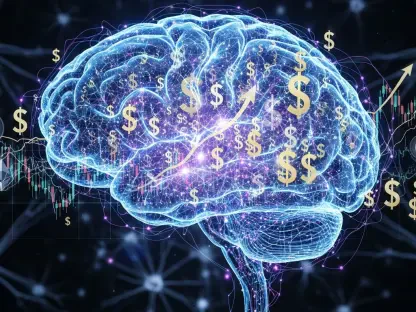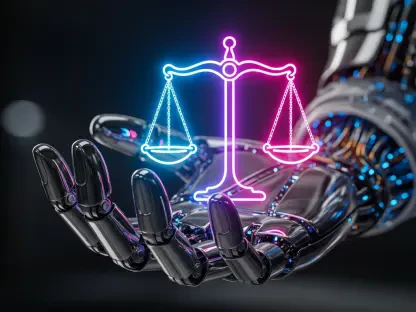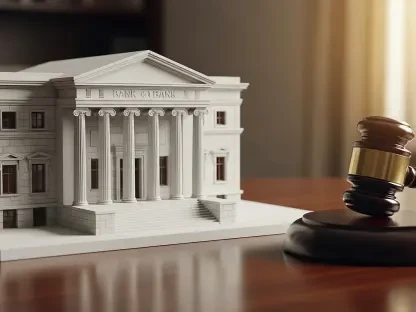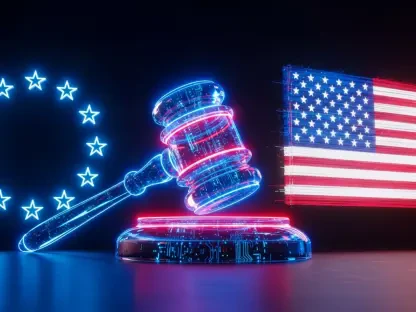Overview of AI and Intellectual Property Landscape
The rapid rise of generative AI technologies has sparked a profound clash with intellectual property rights, creating a battleground where innovation and creativity collide with significant legal and ethical implications. As tools capable of producing art, text, and music proliferate, questions about ownership and fair use have surged to the forefront of debates, challenging long-standing norms and leaving industries grappling with how to protect creators while fostering technological advancement in a digital era.
Generative AI models, such as Stable Diffusion, have transformed creative sectors by enabling the production of high-quality content at unprecedented speed. These tools, often trained on vast datasets scraped from the internet, have become indispensable to artists, designers, and marketers. However, their reliance on existing works raises significant concerns about unauthorized use, prompting pushback from rights holders who fear erosion of their intellectual capital.
Key players like Getty Images, a titan in visual content, and Stability AI, a pioneer in AI image generation, stand at the center of this storm. Their legal confrontation encapsulates broader tensions over training data ethics and the boundaries of intellectual property law. As lawsuits multiply, the industry faces a critical juncture, balancing the promise of AI against the rights of those who fuel its learning.
Details of the Getty vs. Stability AI Case
Background and Allegations
In a high-profile London-based lawsuit, Getty Images accused Stability AI of copyright and trademark infringement, alleging misuse of its vast library of images and branding. The core of the dispute centers on Stability AI’s use of Getty’s content to train its Stable Diffusion models without explicit permission. This practice, Getty argued, undermined its ownership rights and exploited its creative assets for commercial gain.
The allegations extend beyond mere data use, with Getty claiming that Stability AI’s models generated outputs mimicking its recognizable logos, including those of its iStock subsidiary. This raised additional concerns about brand dilution and consumer confusion. Such claims reflect a growing unease among content providers about losing control over their intellectual property in the face of advancing AI capabilities.
Court Ruling and Key Findings
Justice Joanna Smith delivered a nuanced verdict in the case, resulting in a mixed outcome for both parties. The court dismissed Getty’s copyright claims, reasoning that Stability AI did not store or reproduce the images in a manner constituting infringement, especially after Getty withdrew its primary allegations earlier in the proceedings. This aspect of the ruling favored Stability AI, affirming its stance on the legality of its training processes.
However, Getty secured a partial win on trademark grounds, with the court finding that Stability AI infringed on specific protections by allowing its AI to replicate branded logos. The judge held the company accountable as the model provider, rather than shifting blame to end users, emphasizing its role in controlling training data. Justice Smith described the decision as both historic yet narrowly scoped, limiting its applicability to the specific evidence presented.
Both sides claimed victory in the aftermath, highlighting the dual nature of the ruling. Getty celebrated the trademark finding as a step toward protecting intellectual property owners, while Stability AI underscored the dismissal of copyright issues as validation of its practices. This split interpretation mirrors the ambiguity pervading AI-related litigation, where clear-cut resolutions remain elusive.
Challenges in Applying Copyright Law to AI
Navigating the application of copyright and trademark laws to generative AI presents a labyrinth of legal uncertainties. Traditional frameworks, designed for tangible works, struggle to address the intangible and transformative nature of AI outputs. Courts often find themselves interpreting outdated statutes in contexts they were never meant to cover, leading to inconsistent rulings.
A lack of judicial consensus compounds these challenges, as seen in varying outcomes across jurisdictions. While the UK ruling leaned against copyright infringement in this instance, similar cases in the US have produced mixed results, with companies often prevailing under fair use doctrines. This patchwork of decisions creates unpredictability for AI developers and content creators alike, stalling clarity on permissible practices.
Addressing these gaps requires reevaluating existing laws to fit AI-specific scenarios. Proposals for updated frameworks or specialized guidelines are gaining traction, aiming to define boundaries for training data usage. Until such reforms materialize, the legal landscape will likely remain a contentious arena, with each case adding fragmented precedent rather than cohesive policy.
Regulatory Environment Surrounding AI and IP
The current state of intellectual property laws reveals significant disparities in addressing AI technologies. In the UK, courts apply existing copyright and trademark statutes with limited adaptation, as evidenced by the narrow scope of recent rulings. Meanwhile, the US relies on a fair use test that weighs factors like transformative purpose, often favoring tech companies but leaving creators vulnerable.
Trademark protections have emerged as a viable alternative for rights holders in AI disputes, offering a pathway where copyright claims falter. The success of Getty’s trademark argument illustrates how branding laws can serve as a safeguard against misuse of identifiable assets in AI outputs. This trend suggests a potential shift in legal strategies for content owners seeking redress.
Yet, regulatory gaps persist, underscoring the need for clearer guidelines to balance innovation with creator rights. Without comprehensive policies, the tension between fostering AI development and protecting intellectual property will continue to escalate. Policymakers face mounting pressure to craft frameworks that address these challenges, ensuring neither side is disproportionately disadvantaged in a rapidly evolving tech landscape.
Future Implications for AI and Creative Industries
The ramifications of the recent ruling extend far beyond the immediate parties, potentially shaping the operational landscape for AI companies and content creators. Stability AI and similar firms may face heightened scrutiny over training data practices, prompting more cautious approaches or robust licensing agreements. Simultaneously, creators could leverage trademark wins to push for stronger protections against unauthorized use.
Emerging trends point to an intensifying conflict between technological progress and intellectual property safeguards. As AI tools become more sophisticated, the volume of litigation is expected to rise, testing the limits of current legal systems. This growing friction may drive industry stakeholders to seek collaborative solutions, such as standardized data usage protocols, to mitigate disputes.
Looking ahead, future court decisions and regulatory reforms will play a pivotal role in defining the relationship between AI and human creativity. The outcomes of ongoing and upcoming cases could establish critical precedents, influencing how generative models are developed and deployed. The industry stands at a crossroads, where the balance struck in the coming years will determine the sustainability of innovation alongside artistic integrity.
Conclusion and Outlook
Reflecting on the mixed outcomes of the legal battle between Getty Images and Stability AI, it becomes evident that neither side secured a definitive triumph, leaving unresolved questions about AI and intellectual property. The dismissal of copyright claims contrasted with the trademark victory, highlighting the fragmented nature of legal interpretations in this space. This case underscored the urgent need for tailored regulations that could bridge the gap between technological advancement and creator rights.
Moving forward, stakeholders are encouraged to prioritize the development of industry-wide standards for AI training data usage, ensuring transparency and fair compensation for content owners. Collaborative efforts between tech firms and creative communities offer a promising path to reduce friction and foster mutual benefit. Additionally, advocating for legislative updates remains critical to provide clarity and prevent future disputes from stalling progress.
As a next step, establishing pilot programs for ethical AI development is seen as a practical measure to test balanced approaches. These initiatives could inform broader policy changes, paving the way for a framework that supports both innovation and the protection of intellectual assets. The dialogue initiated by this ruling lays a foundation for constructive change, urging all parties to shape a future where technology and creativity can coexist harmoniously.
